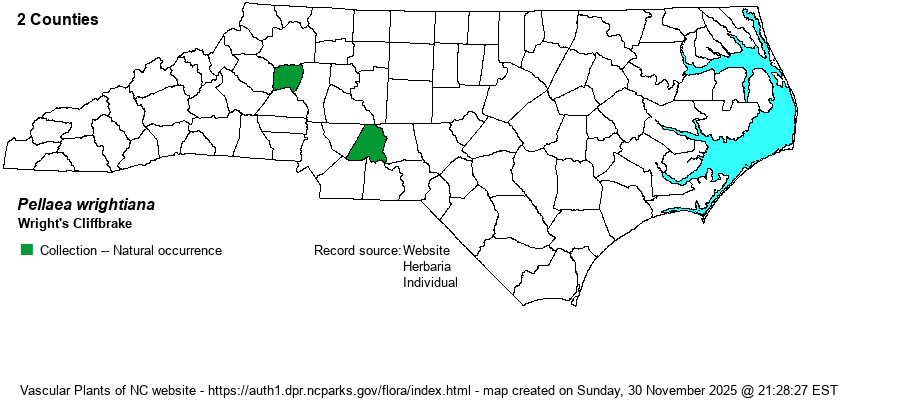| Author | Hooker | |
| Distribution | Known only from a few sites in the Brushy Mountains (Alexander County) and in Stanly County, along the Rocky River. Both sites are in the western and central Piedmont. The iNaturalist website has some correctly identified photos of the species at several sites in central Wilkes County, but the locations (when zoomed in) do not appear to be suitable habitat. Perhaps the observers deliberately reported incorrect coordinates for this sensitive and extremely rare species? The NCNHP database lists it only from single sites in nearby Alexander County and in Stanly County.
This is a Southwestern species, east to CO, AR, TX, and northern Mex.; then highly disjunct well over 1,000 miles east to the few sites in NC and one in western SC! | |
| Abundance | Extremely rare, known from just two sites, one in each of the two counties. Thankfully, the populations at both are still extant, on protected land, and are doing well at the moment. This is a State Endangered species. | |
| Habitat | The two sites in NC are quite different; the Alexander County site is a granitic dome with mafic elements, whereas the Stanly County site is a south-facing bluff on slate. The plants grow in cracks in the rocks and in shallow soil mats around these rock outcrops, and the soils are somewhat circumneutral. | |
| Phenology | Fruits from May to September. | |
| Identification | This is an odd-looking fern, with dimorphic leaves, with the sterile leaf having wider pinnules. The leaves tend to be somewhat glaucous -- light green in color. The sterile leaf has a dark brown stipe of 4-6 inches, and the blade is somewhat longer, to about 8 inches tall long, being bipinnate. The paired pinnae are quite short, most barely 1 inch long, and each one has typically just 3 or 5 pinnules. Each pinnule is oblong to ovate, with a rounded tip and an entire margin, mostly just 1/2-inch long and 1/4-inch wide at most. The pinnule margins are curled-under, generally not obscuring the linear sori that lie along the margins of the pinnules on the leaf underside. In general view, this fern has a quite narrow and "tubular" look, barely 1-1.5 inches wide, and notably few oblong pinnules on a given pinna. | |
| Taxonomic Comments | None
| |
| Other Common Name(s) | None | |
| State Rank | S1 | |
| Global Rank | G5 | |
| State Status | E | |
| US Status | | |
| USACE-agcp | | |
| USACE-emp | | |

